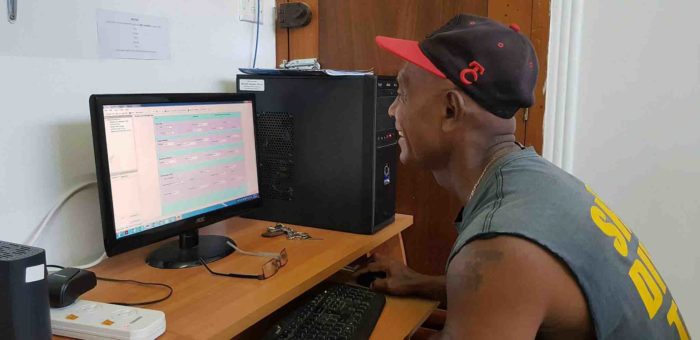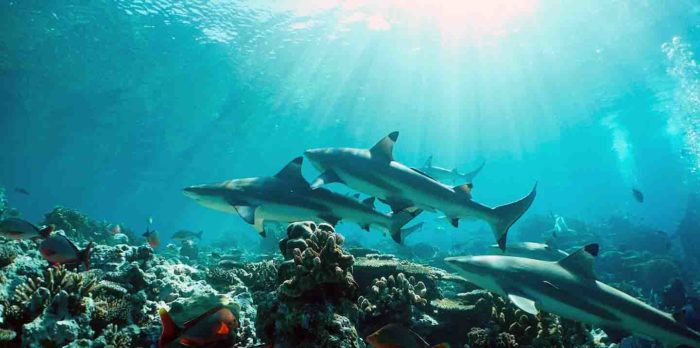
When I was asked if I wanted to go to Fiji to dive with the Bull Sharks for my first OWUSS scholarship experience, as anyone could imagine, the answer was a big YES! After I finally handed in my honours thesis and completed my final seminar for IMAS in Tasmania, I headed to Pacific Harbour, in Fiji to start my first underwater experience. The wonderful team at Beqa Adventure Divers (BAD) run by Mike Neumann, also known as Big Mike, invited Jayne Jenkins and me to dive one of the best shark dive sites in the world as noted by Valerie Taylor, the Shark Reef Marine Reserve, or also known as SRMR. This is a marine sanctuary that the team at BAD has worked closely alongside the Government of Fiji and the traditional owners of the reef, the villages of Wainiyabia and Galoa, to protect up to eight species of shark, including Bull Sharks, Blacktip Reef Sharks, Whitetip Reef Sharks, Silvertip Reef Sharks, Grey Reef Sharks, Sicklefin Lemon Sharks, Tawny Nurse Sharks and Tiger Sharks since 2004.

Once at SRMR we headed down in a group to 30 meters to watch the extremely experienced team feed the sharks in multiple ways, including hand feeding 3 – 4 meter Bull Sharks! For three mornings in a row we were surrounded by up to 40 Bull Sharks – I’ve never seen anything like it, it was truly incredible! At some stages, there were so many sharks it was hard to know where to look, let alone where to point a camera. The team informed me after the first dive that this wasn’t even peak season and when it is they can be surrounded by up to 80 sharks!!!

The dive team, joined alongside by leading marine biologists, not only allow divers to experience a face-to-face encounter with Bull Sharks, but also undertake critical research for the preservation of the marine reserve. Marine biologist, Ben Saqata who was on my dive vessel “Hunter”, utilises a complete spectrum of techniques, from recording important biological features on every dive including who he observes (they each have a name), their size and sex, to taking biopsy samples to understand more about the sharks feeding habits and behaviours, as well as attaching state-of-the-art satellite telemetry devices to the sharks.

After our bottom time was up, we headed up to the 10-meter mark and watched the dive team feed the Whitetip Reef and Grey Reef Sharks and then further to 4-meters to watch them hand feed the Blacktip Reef Sharks. I have never seen so many sharks in one dive, it was unbelievable and this is such a credit to the BAD team, locals and Fijian Government who have worked so hard to protect something so important to the marine ecosystem.

Additionally, we spent the afternoons exploring some of the magical coral reefs around Pacific Harbour, including Seven Sisters, Golden Arch, Scissors Reef, Carpet Cove and Bird Island. Fiji has some of the most beautiful soft coral and Gorgonian reefs I have ever seen. Fish fill these reefs, from sharks to tiny Damselfish, as well as all the tiny creatures everyone loves (especially me) such as nudibranchs. There is so much coral still thriving in Fiji, although the effects of two cyclones earlier this year can be observed on some of the reefs, with some signs of some corals bleaching.



On our last morning in Pacific Harbour, Jayne and I got up early to plant 20 mangrove propagules at sunrise, with the help of Gauthier Mescam, Environmental and Marine Activities Manager at Uprising Beach Resort and Kelly-Dawn Bentley, Marine Scientist at Nanuku Auberge Resort. By planting only 20 mangroves, we manage to offset our carbon footprint from Sydney in Australia to Fiji and almost home!!! I think that is amazing – certainly inspiration to me and hopefully to others to find simple ways to help offset your carbon footprint when travelling around the world.


This experience was truly a once-in-a-lifetime and if I ever get the opportunity to go back to Pacific Harbour, dive with the BAD crew and learn more about their fascinating research I would not hesitate! I could not thank Mike Neuman and the BAD team enough or recommend them more highly to anyone considering shark diving without cages and witnessing first-hand the positive effects marine reserves can have on an ecosystem. A big thank you to Jayne for being a wonderful dive buddy! Again, this opportunity would not have been possible without the incredible support from OWUSS, Rolex, Waterproof International, TUSA, DAN, PADI, Mako Eyewear and of course Reef Photo & Video and Nauticam who allowed me to capture all the amazing moments in Fiji.
